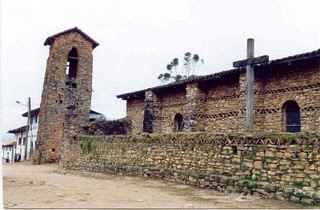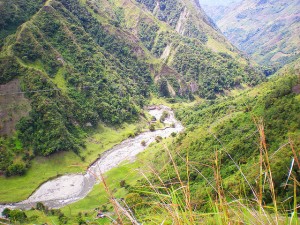
The origins of Rio Toche (or witchcraft in La Jalca)
07 September, 2010Close to the La Jalca town there is a beautiful hill, like a green velvet rug, streched in a little andean valley called “La Pampa de Toche” (The Toche Pampa). Without a doubt it got that name because in the middle of the plain, like a thin, winding snake, flows the Toche river. It’s a river with a beautiful history.
In old times, in La Jalca, there was a woman who lived alone. She dedicated her time to practicing witchcraft. People of the town, knowing about those practices, fearful but indignant, requested the authorities to apply a severe punishment. It was so, after a long process, she was condemned to be beaten to death.

The witch knowing about her judgment and humiliated asked the authorities for clemency. Further she asked the people of the town that were assembled in the square whether she could change her punishment for the gift of water to La Jalca town, something that was vitally lacking at that time. The authorities and the people agreed with pleasure to this offer, but asked that the water came in thirty days.
The witch put certain conditions to fulfill her promise. She needed help constructing a little house in the mountain range, close to the Lic Lic Pugru Lagoon. She also required a large vat and possibly the hardest challenge, a newly-laid egg from a black rooster. All the requirements were fulfilled, by the authorities and with the collaboration of the people.
This was the way it happened. They passed, ten, twenty and thirty days but the water did not come to La Jalca. For this reason there was a new assembly to go and get the lying witch. When the commission came, she said that because of the cold the egg still hadn’t hatched and please, wait just another fifteen days.
During this time, the egg hatched and out came a thin snake, which fed on her milk and grew rapidly. The vat remained to shelter the small snake, the witch took it and left it to fall down into the Lic Lic Pugru Lagoon where it winded its way into the water. The commissioners, reaching the indicated date, returned to say to the witch that not even a drop of water was coming to the town. But she invited them to look at the lagoon where, with very much fright, they saw the great snake that was moving through the water. The commissioners, arming themselves with value in spite of the petitions of the witch, took their slings and stones and started throwing them at it. For this reason, the snake submerged in the lagoon and nobody saw it again.
The witch said: “You should not have bothered the mom of the water. Return to La Jalca and all of you will find a small creek. If you had left it a bit more, the snake would have grown and the town would have had a bigger river.” While the witch was speaking, the lagoon was drying off little by little. Because of this when the commissioners returned to look where the lagoon was, it was only a shallow pond of water and the snake had disappeared. On having been witnesses of this magic spectacle, the commissioners full of fear left the motionless witch and returned fast to La Jalca. It was a big surprise when they observed that at the foot of Quisuar and Toche Pampa a crystalline creek had murmured its way in close to the way.
The commissioners continued running, then drank and refreshed themselves with its limpid waters. On having come already closer from The Jalca, amazed, they contemplated that in Toche’s pampas it caused the river to zig zag and when drawn, took on the shape of a serpent. The commissioners came to the people and found the authorities and everyone in the hill was astonished as they watched what was happening. From that time on water has never been absent for the people of La Jalca.

La Jalca lies in the Chachapoyas region of Amazonas, Peru. It is an area with a rich and diverse cultural heritage. Other famous stories to come from La Jalca include the history of their San Pedro celebrations, which feature a famous bear dance.
Follow Sounds and Colours: Facebook / Twitter / Instagram / Mixcloud / Soundcloud / Bandcamp
Subscribe to the Sounds and Colours Newsletter for regular updates, news and competitions bringing the best of Latin American culture direct to your Inbox.

